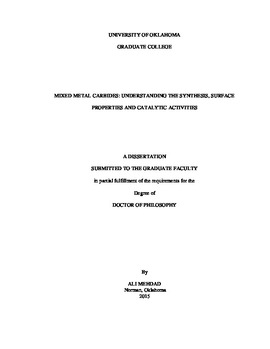| dc.contributor.advisor | Jentoft, Friederike | |
| dc.contributor.author | Mehdad, Ali | |
| dc.date.accessioned | 2015-08-12T19:17:13Z | |
| dc.date.available | 2015-08-12T19:17:13Z | |
| dc.date.issued | 2015-08 | |
| dc.identifier.uri | https://hdl.handle.net/11244/15497 | |
| dc.description.abstract | Metal carbides are formed when carbon is inserted into the lattice of the metal, and metal-carbon bonds are formed. In fact, formation of the carbon-metal bonds causes a change in the electronic structure of the metal in a way that metal carbides can catalyze the reactions that usually are catalyzed by the noble metals.
The effect of variation of the amount of nonmetal (carbon or oxygen) on the catalytic activity of metal carbides was investigated. The metal carbides are pyrophoric materials, and they need to be passivated before coming in contact with the ambient. The results show that water or CO₂ cannot passivate Mo₂C at low temperatures, and at high temperatures they damage the surface of metal carbides by removal of carbidic carbon. However, oxygen can passivate metal carbides at low temperatures. Passivation in 0.1%O₂/Ar instead of 1%O₂/Ar will cause generation of more active sites during reduction. The results revealed that increasing the amount of carbidic carbon or decrease of the amount of oxygen on the (sub) surface of metal carbides results in an increasing the hydrogenation activity. Also, there is a carbon dynamics (adding or removing carbon) on the surface of metal carbide which can alter the catalytic activity of metal carbides.
Metal oxycarbides have bifunctional activity. The conversion of toluene was used to test the bifunctionality of metal (oxy) carbides. Mo₂C has strong metallic behavior and at 20 bar H₂ pressure and 400 °C, hydrogenation and hydrogenolysis products are predominant. In order to modify the metallic behavior of Mo₂C in favor of acid-catalyzed behavior, oxygen was introduced on the surface of Mo₂C to form molybdenum oxycarbide. However, oxygen can be removed at reaction conditions required for ring contraction of six-membered rings to five-membered rings. As a remedy, Mo₂C was mixed with another metal with a higher oxophilicity such as tungsten or niobium. The results indicate that molybdenum-tungsten carbides still have strong metallic behavior with predominant hydrogenation and hydrogenolysis products. However, molybdenum-niobium oxycarbides with cubic NbC structure have lower selectivity to hydrogenolysis products and higher selectivity to ring contraction products compared to Mo-Nb (oxy) carbides with hexagonal Mo₂C structure. The results show that at 400 °C and 20 bar H₂ pressure mixed metal carbides have better stability compared to their corresponding monometallic carbides. | en_US |
| dc.language | en_US | en_US |
| dc.subject | Engineering, Chemical. | en_US |
| dc.title | MIXED METAL CARBIDES: UNDERSTANDING THE SYNTHESIS, SURFACE PROPERTIES AND CATALYTIC ACTIVITIES | en_US |
| dc.contributor.committeeMember | Jentoft, Rolf | |
| dc.contributor.committeeMember | Glatzhofer, Daniel | |
| dc.contributor.committeeMember | Resasco, Daniel | |
| dc.contributor.committeeMember | Lobban, Lance | |
| dc.date.manuscript | 2015-08 | |
| dc.thesis.degree | Ph.D. | en_US |
| ou.group | College of Engineering::School of Chemical, Biological and Materials Engineering | en_US |
